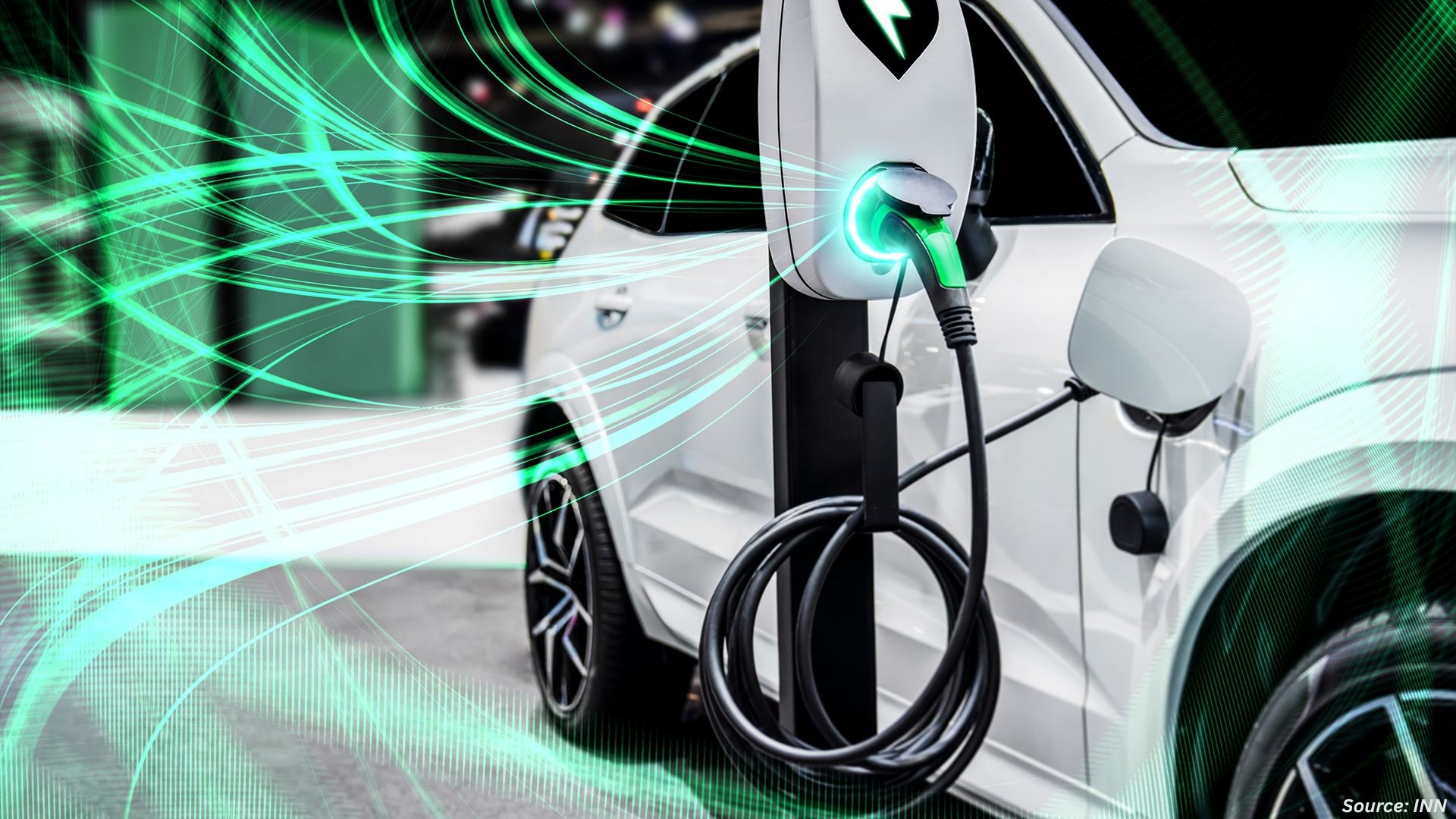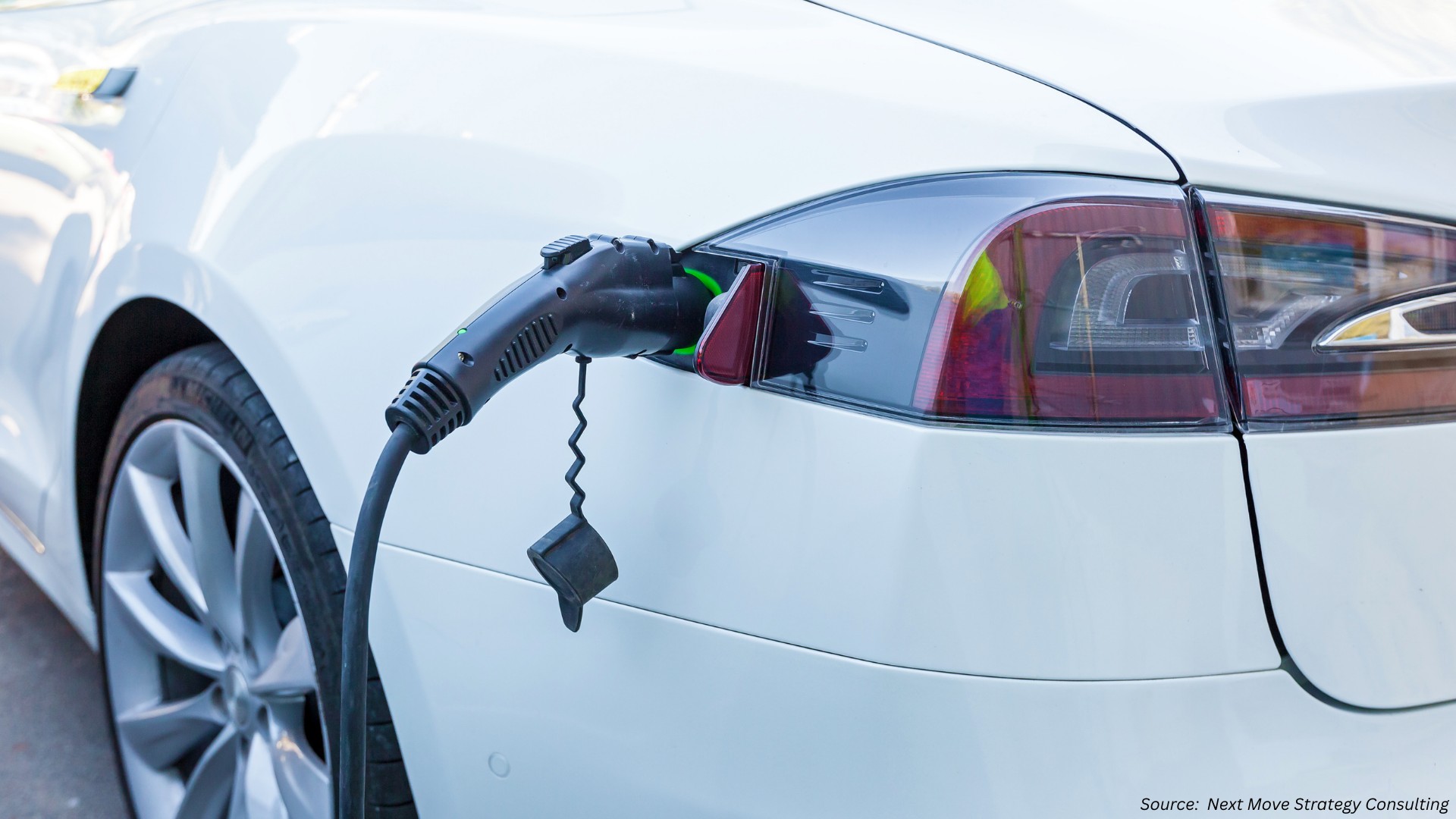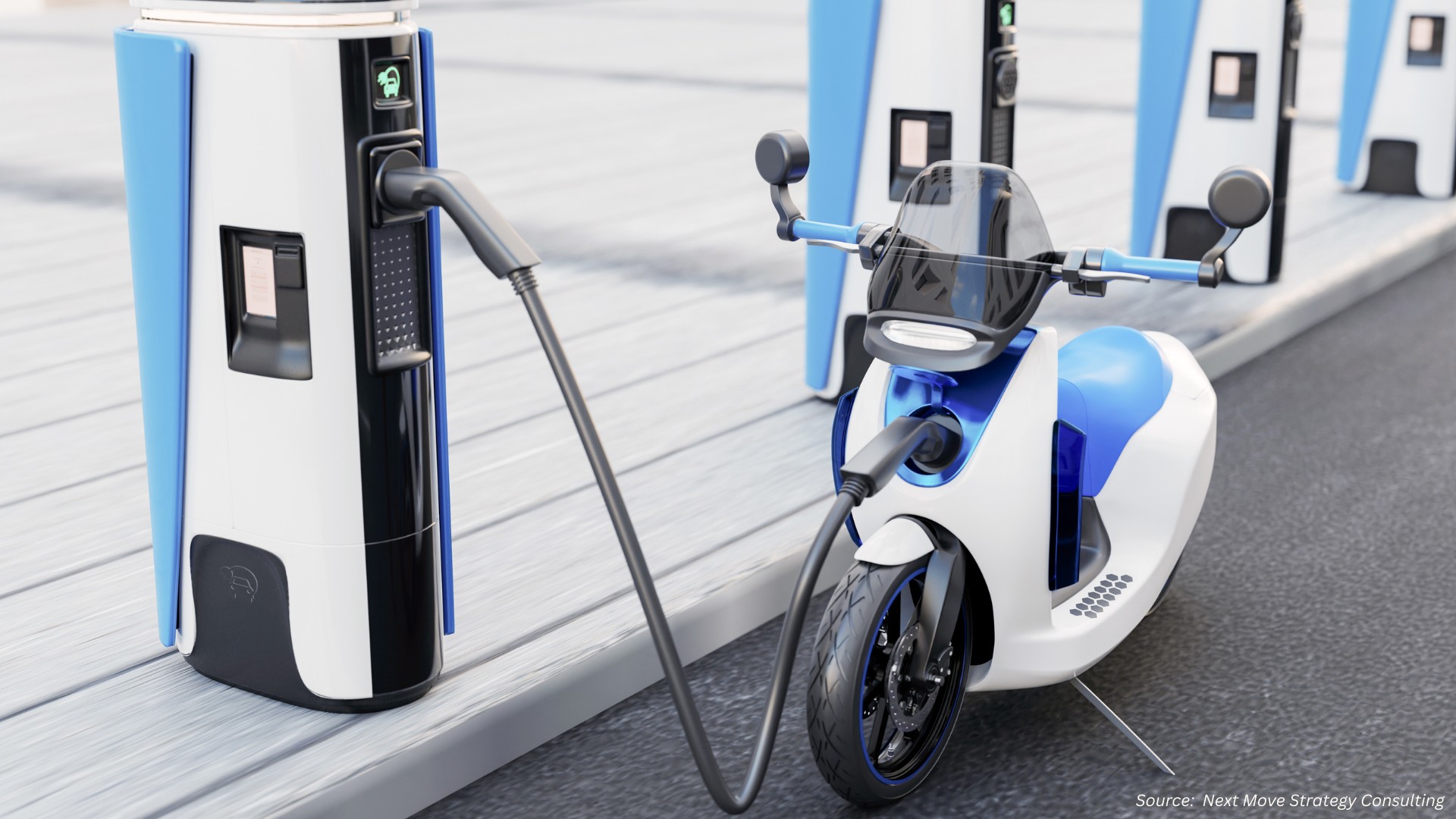
Electric Vehicle Market by Vehicle Components (Battery Cells & Packs, Onboard Charge, Motor, Reducer, Fuel Cell Stack, Power Control Unit, Battery Management System, Fuel Processor, Power Conditioner, Air Compressor, and Humidifier), by Vehicle Type (Passenger Cars, Commercial Vehicles, Two-Wheelers, and Others), by Class ( Low-Priced, Mid-Priced, and Luxury), by Top Speed ( Less Than 100 MPH, 100 to 125 MPH, and More Than 125 MPH) - Global Opportunity Analysis And Industry Forecast, 2022-2030
Industry: Automotive & Transportation | Publish Date: 15-Aug-2025 | No of Pages: 914 | No. of Tables: 656 | No. of Figures: 601 | Format: PDF | Report Code : AT79
Market Overview:
Electric Vehicle Market size was valued at USD 273.4 billion in 2021 and is predicted to reach USD 1869.9 billion by 2030 at a CAGR of 24.4% from 2022-2030.
Electric vehicles are automotive vehicles that are partially or fully powered by electric power. These vehicles are powered by the electricity generated by an electric motor from extravehicular sources stored in a collector or battery system.
Moreover, the battery could be charged by a solar-powered EV charging port by converting solar energy to electricity or a generator EVs function through energy extracted by plugging into a charging point and taking electricity from the power grid. The electricity is stored in rechargeable batteries that power an electric motor to turn the wheels. EV uses various batteries, including lithium-ion, molten salt, zinc-air, and various nickel-based battery designs.
In addition, automotive vehicles include road & rail vehicles, surface & underwater vessels, electric aircraft, and electric spacecraft. Electric vehicles can accelerate faster than vehicles with traditional fuel engines, making them feel lighter to drive.
Growing environmental pollution by conventional transport rises the demand for EVs
The conventional transportation system runs on fossil fuels, a major source of air pollution due to the release of toxic gases such as carbon monoxide, hydrogen, nitrogen oxide, particulate matter, ammonia, and sulfur dioxide into the atmosphere. According to the Intergovernmental Panel on Climate Change (IPCC), without implementing aggressive and sustained mitigation policies, transport emissions could increase faster than emissions from the other energy end-use sectors and reach around 12 Gt CO2eq/year by 2050.
Thus, the growing concerns regarding the negative impact of carbon emissions on the environment and climate have spurred the demand for electric vehicles worldwide, as they are powered by collector systems, including charging stations, inbuilt generators, or solar panels that convert solar energy into electricity. This further increases the demand for electric vehicles in nearly future. According to the estimation of the International Energy Agency (IEA), by 2030, there will be 250 million EVs on the world’s roads to reduce environmental pollution.
Stringent government regulation on carbon emission promotes the growth of EV Market
The rising concerns of ever-increasing greenhouse gases and carbon footprint from the automotive and transportation sector contribute to environmental hazards like climate change, air pollution, and water pollution. Thus, governments impose strict emission standards to reduce carbon emissions and combat climate change, which boosts the demand for electric vehicles. For instance, in November 2021, governments in the US, Canada, Mexico, and the UK jointly committed to fully converting their fleets of 120,000 vehicles to zero emissions by 2040 to reduce greenhouse gas.
Moreover, carbon emission negatively impacts human health by causing several diseases, such as inflammation, reduced cognitive performance, and kidney and bone problems, which drives the market’s growth. According to the World Air Quality Report, in 2021, 63 Indian cities are among the 100 most polluted places in the world due to emissions from the transportation sector.
Absence of standardization in current EV charging infrastructure hinders the market growth
However, the lack of EV charging stations worldwide and inadequate standardization lead to skyrocketing installation costs of charging stations. These factors hamper the public adoption of Evs, which is perceived to restrain the growth of the electric vehicle market growth.
Self Driving EVs create an opportunity for coming years in the market.
Large investments by several governments to provide incentives and subsidies to encourage EV sales and technological advancements such as vehicle-to-grid (V2G) systems and self-driving EVs are expected to create lucrative growth opportunities for the market players in the coming years.
Asia Pacific is projected to hold the largest EV market share
Asia-Pacific dominates the global EV market share and is expected to remain dominant throughout the forecast period. This is attributed to the rising demand for passenger vehicles in developing economies, such as China, India, and Malaysia, and the presence of original equipment manufacturers like Farasis Energy Co., Ltd., Delta Electronics Inc., and XPeng Inc. in this region.
Moreover, China, the world’s largest producer and consumer of EVs, dominates the EV industry, which drives the EV Industry in this region. For instance, according to the World Economic Forum, China is the world’s leading producer of electric vehicles, accounting for around 57.4% of the global EV production and around 500,000 exports in 2021.
Additionally, the new vehicle scrappage policy that aims to transform old vehicles into low-emission ones is expected to drive electric vehicle market share in this region. For instance, in August 2021, the Government of India launched the Vehicle Scrappage Policy to scrap vehicles over 15 years to identify old, unsafe, and polluting vehicles and recycle them in an eco-friendly way.
Europe witnessed substantial growth in the global electric vehicle market.
Europe shows a steady growth in the global EV market growth owing to various government initiatives through subsidiaries and incentives and growing demand for high-performance passenger vehicles. For instance, in September 2020, Germany announced the extension of its EV subsidies and doubled incentives for EVs, offering a €3,000 bonus for fully electric vehicles, €2,250 towards hybrids, a 10-year tax exemption, and lower VAT rates.
Also, electric vehicles witnessed a growing trend of acceptance in Europe owing to improved charging infrastructure and low production costs, along with the government’s efforts to reduce the carbon emission generated by the transportation sector. For instance, the EU introduced CO2 standards for new passenger cars and light commercial vehicles that mandates new car fleets to emit up to 95g CO2/km while light commercial vehicle fleets may emit up to 147g CO2/km with 100% compliance in 2021.
Competitive Landscape
The electric vehicle market share includes several market players such as Tesla Inc, BYD Auto Co. Ltd., Rivian, Volkswagen AG, BMW, Hyundai Motor Company, Bayerische Motoren Werke AG, Ford Motor Company, Mercedes-Benz Group AG, Guangzhou Xiaopeng Automotive Technology, Toyota Motor Corporation, Nissan Motor Corporation, General Motors, Renault S.A., GAC Aion New Energy Automobile Co., Ltd..
They have adopted various growth strategies, such as innovation and collaboration, to maintain their global EV market size.
For instance, in September 2022, BYD announced its plans to build a factory in Thailand for manufacturing electric vehicles for the Southeast Asian market. The company expects to build 150,000 electric passenger cars at the new Thai factory starting in 2024. The Thailand Board of Investment approved the plans for the new factory. Through this strategy the company aims to expand its presence over other countries, which in turn fuels the growth of EV industry.
Additionally, in April 2021, Toyota Corporation introduced a brand-new series of battery electric vehicles (BEVs), Toyota bZ, to establish its full line-up of electrified vehicles. The company plans to introduce 15 BEVs, including seven Toyota bZ models, by 2025, to increase their dominance over global EV market.
Moreover, in November 2021, Tesla launched its new version of the Gen 2 wall connector with a J1772 connector. This EV charging station, in contrast to its earlier models, is appropriate for all EV models offered on the North American market, which will drive the growth of EV in the region.
Key Market Segments
By Vehicle Components
-
Battery Cells & Packs
-
Onboard Charge
-
Motor
-
Reducer
-
Fuel Cell Stack
-
Power Control Unit
-
Battery Management System
-
Fuel Processor
-
Power Conditioner
-
Air Compressor
-
Humidifier
By Vehicle Type
-
Passenger Cars
-
Commercial Vehicles
-
Two-Wheelers
-
Others
By Vehicle Class
-
Low priced
-
Mid-priced
-
Luxury
By Top Speed
-
Less Than 100 MPH
-
100 to 125 MPH
-
More Than 125 MPH
By Drive type
-
Front-Wheel Drive
-
Rear-Wheel Drive
-
All-Wheel Drive
By Charging Point Type
-
AC / Normal Charging
-
DC /Super Charging
-
Inductive Charging
By Vehicle Connectivity
-
V2B or V2H
-
V2G
-
V2V
-
V2X
By Propulsion Type
-
BEV
-
PHEV
-
FCEV
-
HEV
By End User
-
Private
-
Commercial Fleets
-
Shared Mobility
-
Micromobility
-
Public Transport
-
Industrial Use
By Charging Standard
-
Guobiao Standards
-
Charge De Move (Chademo)
-
Combined Charging System (CCS)
-
Tesla Supercharger
-
Type 1 (SAE J1772)
-
Type 2 (IEC 62196)
By Region
-
North America
-
The U.S.
-
Canada
-
Mexico
-
-
Europe
-
The UK
-
Germany
-
France
-
Italy
-
Spain
-
Denmark
-
Netherlands
-
Finland
-
Sweden
-
Norway
-
Russia
-
Rest of Europe
-
-
Asia Pacific
-
China
-
Japan
-
India
-
South Korea
-
Australia
-
Indonesia
-
Singapore
-
Taiwan
-
Thailand
-
Rest of Asia Pacific
-
-
RoW
-
Latin America
-
Middle East
-
Africa
-
Key Market Players
-
Tesla Inc
-
BYD Auto Co. Ltd.
-
Rivian
-
Volkswagen AG
-
BMW
-
Hyundai Motor Company
-
Bayerische Motoren Werke AG
-
Ford Motor Company
-
Mercedes-Benz Group AG
-
Guangzhou Xiaopeng Automotive Technology
-
Toyota Motor Corporation
-
Nissan Motor Corporation
-
General Motors
-
Renault S.A.
-
GAC Aion New Energy Automobile Co., Ltd.
REPORT SCOPE AND SEGMENTATION:
|
Parameters |
Details |
|
Market Size in 2022 |
USD 326.6 Billion |
|
Revenue Forecast in 2030 |
USD 1869.9 Billion |
|
Market Volumes in 2022(000’ units) |
9527.11 |
|
Volumes Forecast in 2030(000’ units) |
55124.57 |
|
Growth Rate |
CAGR of 24.4% from 2022 to 2030 |
|
Analysis Period |
2021–2030 |
|
Base Year Considered |
2021 |
|
Forecast Period |
2022–2030 |
|
Market Size Estimation |
Billion (USD) |
|
Growth Factors |
Growing environmental pollution by conventional transport |
|
Countries Covered |
26 |
|
Companies Profiled |
10 |
|
Market Share |
Available for 10 companies |
|
Customization Scope |
Free customization (equivalent up to 80 analysts working hours) after purchase. Addition or alteration to country, regional & segment scope. |
|
Pricing and Purchase Options |
Avail customized purchase options to meet your exact research needs. |




















 Speak to Our Analyst
Speak to Our Analyst

























